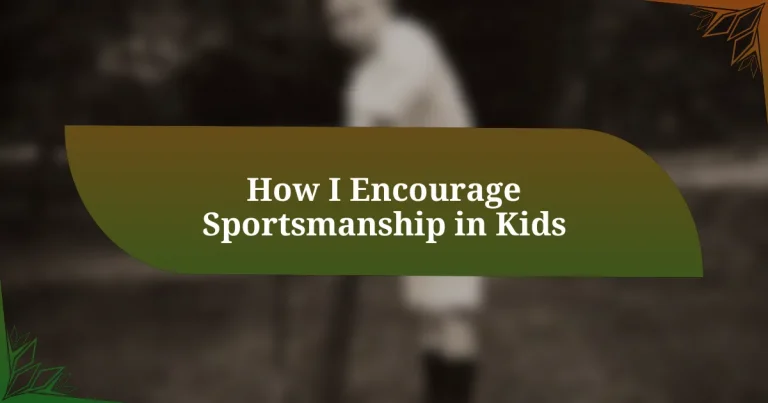Key takeaways:
- Instilling sportsmanship in children fosters emotional intelligence, resilience, and healthier relationships both on and off the field.
- Playing cricket enhances physical coordination, focus, perseverance, and the importance of teamwork, creating bonds among diverse players.
- Leading by example and setting clear behavioral expectations encourage respect, fairness, and accountability in young athletes.
- Celebrating moments of sportsmanship and recognizing positive behavior fosters a supportive team culture and emphasizes the spirit of the game.
Importance of sportsmanship in kids
In my experience, instilling sportsmanship in kids is crucial for their overall development. When I see young players shake hands after a match, it warms my heart; it’s a simple gesture that fosters respect and camaraderie. Do you remember feeling that thrill of winning and losing as a child? Those moments teach them how to handle success gracefully and bounce back from setbacks.
Sportsmanship not only improves teamwork but also builds character. I once coached a team that lost a big game. Instead of sulking, the kids rallied to support each other, demonstrating resilience and empathy. How often do we see adults struggle with these very qualities? Teaching kids sportsmanship early helps them cultivate emotional intelligence that lasts a lifetime.
Moreover, practicing good sportsmanship encourages inclusive play, making it easier for everyone to enjoy the game. I’ve witnessed shy kids blossom when they feel accepted and valued by their teammates. Isn’t it rewarding to see children learn to cheer for others, regardless of the outcome? These lessons form the foundation for healthy relationships on and off the field.
Benefits of playing cricket
Playing cricket offers numerous benefits, both physically and mentally. From my own experience, the game not only enhances coordination and fitness but also improves focus. I remember a local tournament where I saw kids who were previously distracted really concentrating, evolving into more adept players. Isn’t it fascinating how a sport like cricket can help children develop such crucial life skills?
Cricket also teaches valuable lessons in perseverance and goal setting. I once watched a young bowler who struggled to take a wicket throughout the match. Instead of giving up, he kept practicing and finally succeeded in his final over. That sense of achievement lit up his face! It’s amazing to witness how overcoming challenges in sports translates into a resilient attitude in other areas of life.
As a team sport, cricket fosters a strong sense of community and belonging. I recall coaching a diverse group of kids, each bringing their unique backgrounds and experiences. Watching them bond over shared victories and losses created friendships that extended beyond the cricket field. Isn’t it heartwarming to see children forming connections through teamwork? These interactions help them understand diversity and collaboration, which are essential in today’s world.
Teaching cricket fundamentals
Teaching the fundamentals of cricket is crucial for building a solid foundation in young players. I believe that having a strong grasp of the basics—like grip, stance, and footwork—can make a significant difference in how confident kids feel on the field. I recall a session with a group of beginners where we focused solely on batting stance. Watching their posture improve instantly boosted their self-esteem, showing just how much of an impact technique can have.
When I introduce bowling techniques, I often emphasize the importance of rhythm and accuracy. I once coached a girl who struggled with overstepping while bowling; after practicing her run-up repeatedly, she finally hit the mark. The joy on her face after her first legitimate delivery sent my heart soaring. It’s moments like these that highlight how mastering fundamentals can transform both skill and self-belief in young athletes.
Fielding is just as important, and I like to make it fun! One time, I organized a “fielding challenge” where kids raced to catch balls thrown from different angles. Their laughter and friendly competition not only sharpened their skills but also fostered a sense of camaraderie. Isn’t it incredible how teaching fundamentals can create an environment where both learning and joy coexist?
Encouraging teamwork in cricket
Creating a sense of teamwork in cricket can be transformative for young players. I remember one specific match where I paired two players who were more focused on individual glory. Throughout the game, I encouraged them to communicate and strategize together. By the end, they were not only celebrating each other’s successes but also forming a bond that went beyond the field. Isn’t it amazing how a little encouragement can turn competition into collaboration?
Another practice I find effective is incorporating team drills that require cooperation. For instance, I often set up a scenario where players have to field together in pairs, guiding one another on positioning and technique. The laughter and chatter during these drills highlight how teamwork can make the practice enjoyable. It’s moments like this that remind me of the joy of cricket—not just the game itself, but the relationships we build along the way.
Promoting team spirit goes beyond just drills and matches. I encourage my players to share thoughts and experiences after games. I once facilitated a post-match discussion where we celebrated what went well and how they supported each other. It was heartwarming to see them recognize the value of teamwork, creating a supportive culture on and off the field. How often do we take a moment to reflect on our collective journey?
Leading by example in sports
Leading by example in sports is essential for instilling values in young players. I often think about my own experiences as a kid when my coach would display fairness and kindness, regardless of the scoreline. This modeling behavior taught us that how we conduct ourselves is just as important as winning. Have you ever noticed how children watch and mimic adult behavior?
During practice, I strive to demonstrate good sportsmanship in every situation, whether it’s congratulating an opponent or simply acknowledging a teammate’s effort. There was a time when a player experienced a tough loss. Instead of shying away, I approached him, shared my own challenging moments, and emphasized the importance of grace in defeat. It amazed me how quickly he began to embody that same spirit, showing that leading by example isn’t just about words; it’s about sharing experiences.
I find that my actions often resonate with the kids more than what I say. For example, when I drop everything to cheer for a teammate who’s struggling, I see their eyes light up. In those moments, they realize that support and encouragement can create an environment where every player thrives. Isn’t it incredible how the simplest actions can foster a community of respect and sportsmanship?
Setting clear expectations for behavior
Setting clear expectations for behavior is a crucial bridge between learning sports and embracing sportsmanship. I often gather the kids before practice and lay out what I expect from them in terms of respect, fairness, and teamwork. It’s amazing how just outlining these simple principles creates a shared understanding and commitment among them, as if we’re all part of a team beyond the game itself.
I remember one instance when we discussed sportsmanship before a big match. I could sense the excitement—and the nervousness—in the air. It struck me how much they wanted to win, but sharing stories about players who show grace, no matter the outcome, shifted their focus. By agreeing to uphold these values together, we created a shared pledge that bound us, making it clear that good behavior is just as vital as skill.
To reinforce these expectations, I frequently check in with the players. When I observe a moment of unsportsmanlike conduct, I don’t just intervene; I guide them through a conversation about how our actions reflect who we are. I often ask, “How would you feel if you were in that situation?” This not only holds them accountable but also encourages empathy, reminding them that every player is deserving of respect.
Celebrating sportsmanship achievements
Recognizing and celebrating moments of sportsmanship can transform the team culture. Recently, during a match, I witnessed one of our players help an opponent who had fallen. The parents and kids cheered, and it was heartwarming to see how that small act radiated positivity throughout the field. Moments like these deserve celebration because they embody the essence of being a good sport, reminding everyone about the true spirit of the game.
I remember after one particularly intense match, we felt the need to reflect on our experiences. We had a small gathering where each player shared something positive they noticed about a teammate’s sportsmanship. When one player spoke up about another defending a teammate during a dispute, it sparked joy and pride across the group. Isn’t it amazing how acknowledging these traits can foster a sense of community among young athletes?
Creating a tradition of announcing “sportsmanship heroes” at the end of each practice has made a remarkable impact. This isn’t just about praising the best players; it’s about valuing kindness and respect. I see their eyes light up when they receive this recognition, which motivates them to act with integrity. Doesn’t this approach reinforce the message that true sportsmanship is as important as scoring runs or taking wickets?



